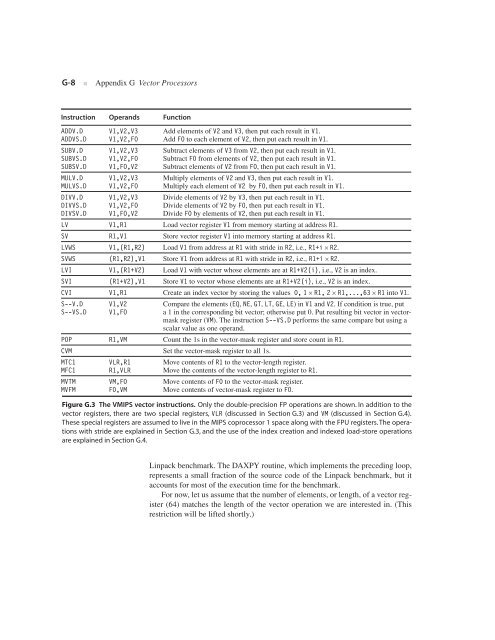Appendix G - Clemson University
Appendix G - Clemson University
Appendix G - Clemson University
You also want an ePaper? Increase the reach of your titles
YUMPU automatically turns print PDFs into web optimized ePapers that Google loves.
G-8<br />
■<br />
<strong>Appendix</strong> G<br />
Vector Processors<br />
Instruction Operands Function<br />
ADDV.D<br />
ADDVS.D<br />
SUBV.D<br />
SUBVS.D<br />
SUBSV.D<br />
MULV.D<br />
MULVS.D<br />
DIVV.D<br />
DIVVS.D<br />
DIVSV.D<br />
V1,V2,V3<br />
V1,V2,F0<br />
V1,V2,V3<br />
V1,V2,F0<br />
V1,F0,V2<br />
V1,V2,V3<br />
V1,V2,F0<br />
V1,V2,V3<br />
V1,V2,F0<br />
V1,F0,V2<br />
Add elements of V2 and V3,<br />
then put each result in V1.<br />
Add F0 to each element of V2,<br />
then put each result in V1.<br />
Subtract elements of V3 from V2,<br />
then put each result in V1.<br />
Subtract F0 from elements of V2,<br />
then put each result in V1.<br />
Subtract elements of V2 from F0,<br />
then put each result in V1.<br />
Multiply elements of V2 and V3,<br />
then put each result in V1.<br />
Multiply each element of V2 by F0,<br />
then put each result in<br />
Divide elements of V2 by V3, then put each result in V1.<br />
Divide elements of V2 by F0, then put each result in V1.<br />
Divide F0 by elements of V2, then put each result in V1.<br />
LV V1,R1 Load vector register V1 from memory starting at address R1.<br />
SV R1,V1 Store vector register V1 into memory starting at address R1.<br />
LVWS V1,(R1,R2) Load V1 from address at R1 with stride in R2, i.e., R1+i × R2.<br />
SVWS (R1,R2),V1 Store V1 from address at R1 with stride in R2, i.e., R1+i × R2.<br />
LVI V1,(R1+V2) Load V1 with vector whose elements are at R1+V2(i), i.e., V2 is an index.<br />
SVI (R1+V2),V1 Store V1 to vector whose elements are at R1+V2(i), i.e., V2 is an index.<br />
CVI V1,R1 Create an index vector by storing the values 0, 1 × R1, 2 × R1,...,63 × R1 into V1.<br />
S--V.D V1,V2 Compare the elements (EQ, NE, GT, LT, GE, LE) in V1 and V2. If condition is true, put<br />
S--VS.D V1,F0 a 1 in the corresponding bit vector; otherwise put 0. Put resulting bit vector in vectormask<br />
register (VM). The instruction S--VS.D performs the same compare but using a<br />
scalar value as one operand.<br />
POP R1,VM Count the 1s in the vector-mask register and store count in R1.<br />
CVM Set the vector-mask register to all 1s.<br />
MTC1 VLR,R1 Move contents of R1 to the vector-length register.<br />
MFC1 R1,VLR Move the contents of the vector-length register to R1.<br />
MVTM VM,F0 Move contents of F0 to the vector-mask register.<br />
MVFM F0,VM Move contents of vector-mask register to F0.<br />
Figure G.3 The VMIPS vector instructions. Only the double-precision FP operations are shown. In addition to the<br />
vector registers, there are two special registers, VLR (discussed in Section G.3) and VM (discussed in Section G.4).<br />
These special registers are assumed to live in the MIPS coprocessor 1 space along with the FPU registers. The operations<br />
with stride are explained in Section G.3, and the use of the index creation and indexed load-store operations<br />
are explained in Section G.4.<br />
Linpack benchmark. The DAXPY routine, which implements the preceding loop,<br />
represents a small fraction of the source code of the Linpack benchmark, but it<br />
accounts for most of the execution time for the benchmark.<br />
For now, let us assume that the number of elements, or length, of a vector register<br />
(64) matches the length of the vector operation we are interested in. (This<br />
restriction will be lifted shortly.)<br />
V1.

















